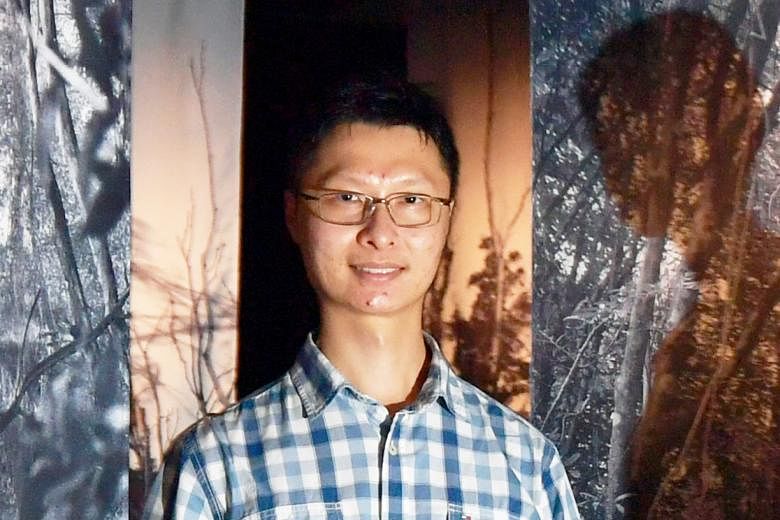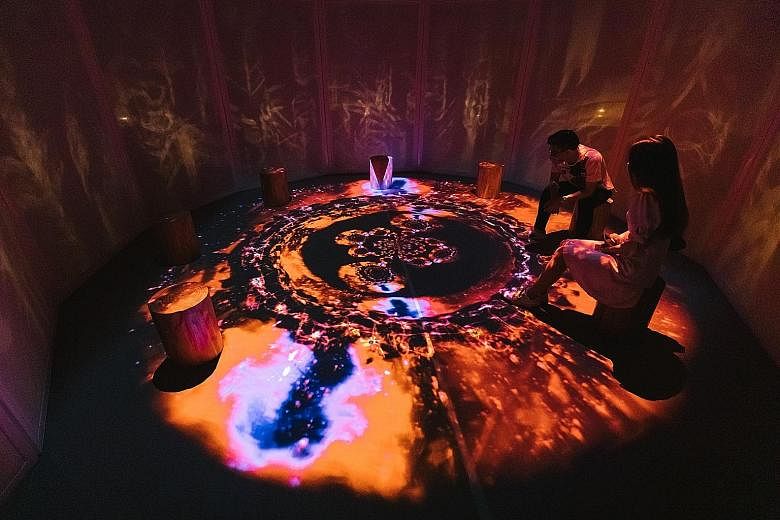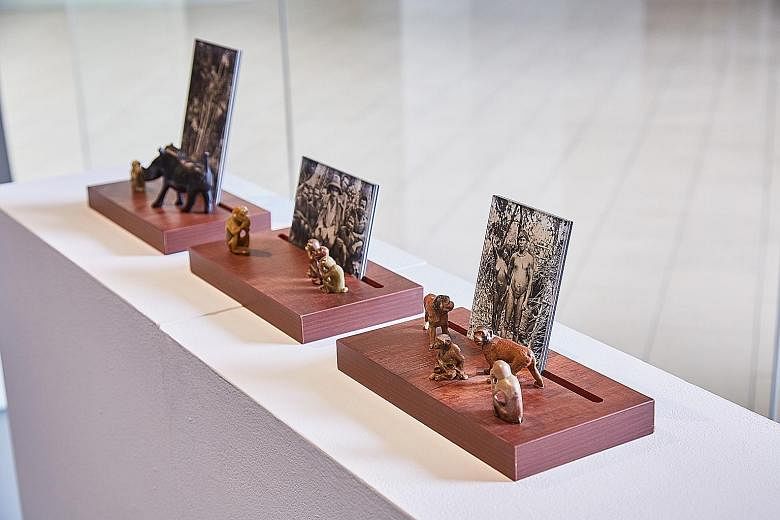How do you replicate the ambience of a forest? Artist Zen Teh, 32, probes this question in a new multisensory installation at Nanyang Technological University.
Visitors take off their shoes and step into a darkened exhibition space, wending their way around 34 fabric banners. These feature night-time images of vegetation in Singapore's parks and nature reserves, whose trees are penetrated by nearby urban light.
Taking a turn around the room, one encounters the sounds and smells of nature - in the form of an artificial soundscape by audio artist Brian O'Reilly and aromatic scents by scientist Ching Jianhong.
A Familiar Forest, as the work is known, has taken root in the university's new rest and relaxation space Hygge, and runs till January next year.
It is one of several art exhibitions here looking at mankind's relationship with nature - a perennial issue on the land-scarce island, where the impending clearing of green areas such as Clementi Forest has sparked public outcry.
Teh, who was born Teh Shi Wei and added Zen to her name as a reminder "to follow a natural way of life", is worried about deforestation.
"We talk about Tengah 'forest town' - how much of the actual forest do we retain? When we build, are we building with respect to the natural environment, or are we clearing all and then building and planting back some trees?
"If we lose so much of our natural forest, but still desire to see some parts of nature, we may have to turn to images, artificial sounds, and so on," says Teh, whose exhibition is an extension of a 2015 solo show Sensing States: Healing Spaces at the ArtScience Museum.
Dr Ching, an assistant professor and co-director of Duke-NUS Medical School's Metabolomics Facility, worked with Teh on the exhibition and weighed in on the therapeutic effects of nature.
"She has replicated the beauty, sound and smell of nature. But can you replicate the health benefits of walking through a forest?" asks Dr Ching, 39. "When you consume an orange, it is different from just taking a vitamin C pill."
Over at Lasalle College of the Arts, Donna Ong's Blueprints For The Forest explores people's depictions of the forest - from dry scientific observations to images coloured by colonial prejudice - and the gap between the real and imagined forest.
-
VIEW IT/A FAMILIAR FOREST
-
WHERE: Hygge, Lee Wee Nam Library, Nanyang Technological University, 50 Nanyang Avenue, North Spine 3
WHEN: Till Jan 20, 2022, 8.30am to 9.15pm (weekdays), 6.45pm (weekdays during holidays) or 4.45pm (Saturdays). Closed on Sundays
ADMISSION: Free. Members of the public should e-mail library@ntu.edu.sg to arrange a visit
INFO: bit.ly/3rYkQ4c
-
VIEW IT/ESCAPE VELOCITY V
-
WHERE: City Hall Wing, Level B1, The Ngee Ann Kongsi Concourse Gallery, National Gallery Singapore, 1 St Andrew's Road
WHEN: Till March 14, 10am to 7pm daily
ADMISSION: Free for Singaporeans and permanent residents
INFO: bit.ly/3s75nz3
-
VIEW IT/BLUEPRINTS FOR THE FOREST
-
WHERE: Earl Lu Gallery, Institute of Contemporary Arts Singapore, Lasalle College of the Arts, 1 McNally Street
WHEN: Till March 17, noon to 7pm (Mondays to Saturdays). Closed on Sundays and public holidays
ADMISSION: Free
INFO: bit.ly/3bjc76a
On display are antique European lithographs of Amazon and South-east Asian jungles, many of which appeared in encyclopaedias; stacks of National Geographic magazines; and books such as Green Mansions: A Romance Of The Tropical Forest by British naturalist William Henry Hudson.
Ong, 42, has also created square magnets from sections of National Geographic photos; and panels of acrylic tiles with colours used in military camouflage uniforms.
A video installation on the far side of the gallery affords views of manicured "tropical" greenery in places such as Jurong Bird Park, Khoo Teck Puat Hospital and the London Zoo.
"I'm interested in how the forest is depicted and how this affects our view of the forest and how we act towards it."
Ong adds: "Singapore is in the tropics, but we create these manicured gardens. It's like 'beta' tropics, 'improved' tropics."
Artist Zai Tang, 36, imagines a different relationship between people and the natural world - one that is less human-centric.
Escape Velocity V, an immersive sound installation presented by the Singapore Art Museum at the National Gallery Singapore, explores what it means to listen to nature in a time of ecological crisis.
It features a 16-minute audiovisual presentation, based on field recordings from areas which are rich in biodiversity but threatened by urban development - Bukit Brown Cemetery, MacRitchie Reservoir, the Rail Corridor and forests near the Mandai Project, billed as an integrated wildlife and nature destination.
In the sound installation, what begins as a kind of natural soundscape grows increasingly harried, even mechanical, reflecting Tang's concerns for the world.
One of his criticisms of the Mandai Project, he says, is that it aims to connect people with nature but "could only imagine doing so through the heavy-handed, large-scale intervention and disruption of existing habitats which already had an intrinsic environmental value".
"I'd argue that rather than closing the gap between 'us' on one side and 'nature' on the other, it simply recreates it," he adds.
What does it mean, then, to listen to nature at a time like this?
Tang says: "In this time of ecological crisis, there is an urgent need to develop a deeper affectual and intellectual understanding of what nature is and rediscover our place within it.
"Listening can be one such process - a means of building a sense of interconnection, care and solidarity within the world."





